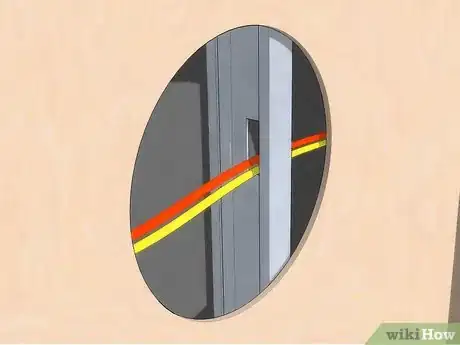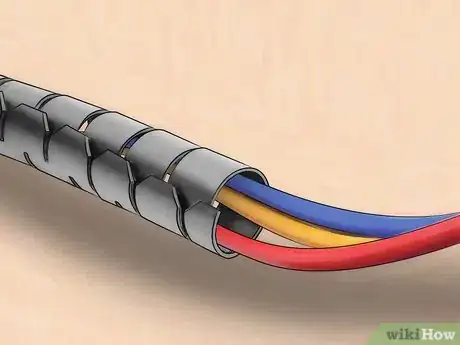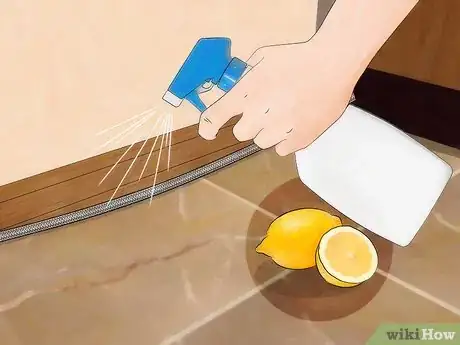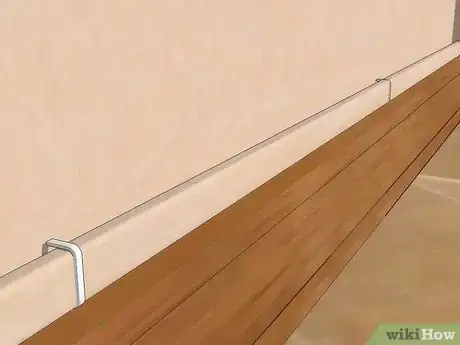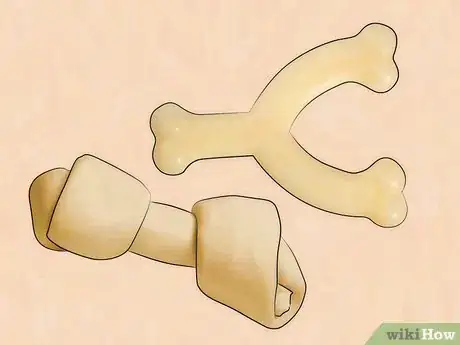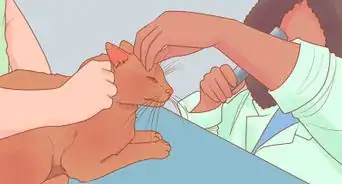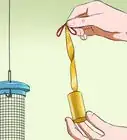This article was co-authored by Jamie Freyer, DVM. Dr. Jamie Freyer is a Licensed Doctor of Veterinary Medicine based in Washington. With over ten years of experience in clinical practice and industry, she specializes in veterinary medicine and surgery, animal behavior, and animal genetics. Dr. Freyer holds a BS in Life Science from The University of Portland and a DVM from Oregon State University.
There are 10 references cited in this article, which can be found at the bottom of the page.
This article has been viewed 169,581 times.
Of all the aspects of pet safety, there’s one risk that pet owners often overlook: the dangers that household cables can present to animals. Chewing cables can send an electric shock through your pet, which can cause burns, shutdown of vital organs, and eventual death.[1] Damaged cords can also be quite expensive to replace! Animals and cables just don’t mix, but you can use these pet-proofing techniques to help them safely co-exist in your home.
Steps
Blocking Access to Cables
-
1Block access to cords with furniture. [2] Take advantage of any sturdy object in your home that can act as a barrier between your pet and electrical cords. Tuck as many cords as you can under or behind bookcases, TV stands, cabinets, and dressers.
- If you have large pets, you can simply tuck many power cables under or behind furniture. However, smaller pets, such as cats or ferrets, can squeeze into extremely small spaces, which may make it harder to apply this method.
- Attach the cords to table or desk legs using wire ties. Pets are more likely to chew loose wires.
- You can also run electrical cords under rugs or other floor mats.
Veterinarian Pippa Elliott emphasizes: "No one ever thinks their pet will be electrocuted, but it happens. Young animals of any species and rodents of all ages have a need to chew, and will test their teeth on anything they can find. Always assume the worst will happen and tidy away those cables."
-
2Lift cords out of your pet’s reach. Getting them off the floor and affixing them to walls and furniture surfaces with adhesive-backed cord clips covers all the bases, because pets can’t hurt themselves with something they don’t even have access to!
- Use your cords to create wall art. Use u-shaped cable brackets to mount cords to the wall in loops or other fun patterns. [3]
Advertisement -
3Run cables through the walls. If you have drywall, it can be relatively easy to drill two small holes through which you can thread your cords. Use a tool such as fish tape or a cable puller to feed the cord through the wall.
- Cords can also be threaded through the attic or basement.
- Put detachable cords away. The power supply for a laptop or other portable device can be particularly easy to damage and expensive to replace, so put these cables away instead of leaving them out to be chewed.
-
4Wind up excess cord lengths. Excess cord and cable lengths can be strangulation hazards to cats and dogs, so get the extra length under control with a cord winder. Excess cables also tend to stick out, making them more attractive to pets.
- Make sure you don’t stop with electrical cables. Long cords on window treatments can also become wrapped around your pet’s neck, so don’t forget to tackle those, too!
Covering Cables
-
1Wrap cords. This is the easiest and least expensive approach. Use corrugated wire loom tubing or plastic spiral wrap, which are available from many office supply and other stores.
- Some tubing and wrap may not be strong enough to protect cords from persistent pets. PVC piping is a sturdier option, but is also less flexible.
-
2Mount wire channels along the wall to provide a protected path for cords. These metal or plastic conduits are commonly used to add electrical outlets to the outer surface of solid walls, so many styles are available.
- Flat wire channels are also available for running cords across bare floors.
- Hide wire channels inside baseboards and crown molding. Products are available with channels pre-installed, or if you're handy you can hollow out the channels yourself.[4]
-
3Run cords through metallic braided sleeving. If you have small pets with tiny, sharp teeth, this sleeving, which is available in a variety of materials and colors, can protect your cords. [5]
- These sleeves are often used to prevent electrical cables from causing interference with other electronic devices, so you're more likely to find it at stores that sell electrical and electronic supplies.
-
4Use a homemade solution. For example, a garden hose can provide flexibility for snaking wires around furniture while still providing protection for your pets. Also consider making a custom charging station using a cardboard box and a few simple tools. [6]
- Decorate your cables with beads. Plastic crafting beads can provide colorful and stylish protection.[7]
Convincing Pets Not to Chew
-
1Apply an anti-chewing spray. Lemon juice, hot sauce, or pepper mixed in water will all deter most pets.[8]
- Observe electrical safety for yourself! Water conducts electricity, so make sure you're not touching the electrical wires or appliances while applying the spray. [9]
- These substances will dissipate over time, so you'll have to reapply them periodically.
-
2Camouflage your cables so that they blend in with their surroundings. Choose cords or cable-covering supplies that are a close color match to your floors and walls… if your cords don’t stand out, your pet will be much less likely to play with or chew on them.
- You may be able to paint your electrical cords. If not, you can use colored electrical tape to match the surrounding colors.
-
3Provide an alternative. Pets who chew are often bored or frightened. Addressing the core problem by providing appropriate chew toys, playtime, and other activities may decrease chewing in general. [10]
- Train your pet to chew a toy by associating it with food. Some toys come pre-flavored; others can be filled with food or treats.
Expert Q&A
-
QuestionHow do you protect electrical cords from pets?
 Jamie Freyer, DVMDr. Jamie Freyer is a Licensed Doctor of Veterinary Medicine based in Washington. With over ten years of experience in clinical practice and industry, she specializes in veterinary medicine and surgery, animal behavior, and animal genetics. Dr. Freyer holds a BS in Life Science from The University of Portland and a DVM from Oregon State University.
Jamie Freyer, DVMDr. Jamie Freyer is a Licensed Doctor of Veterinary Medicine based in Washington. With over ten years of experience in clinical practice and industry, she specializes in veterinary medicine and surgery, animal behavior, and animal genetics. Dr. Freyer holds a BS in Life Science from The University of Portland and a DVM from Oregon State University.
Licensed Veterinarian Try using a wire collector that keeps all the cables in one place, away from your pets. If there's an area where you have to have a bunch of wires, a baby gate or something similar can help keep them away from the wires.
Try using a wire collector that keeps all the cables in one place, away from your pets. If there's an area where you have to have a bunch of wires, a baby gate or something similar can help keep them away from the wires. -
QuestionHow do I stop my dog from chewing electrical cords?
 Jamie Freyer, DVMDr. Jamie Freyer is a Licensed Doctor of Veterinary Medicine based in Washington. With over ten years of experience in clinical practice and industry, she specializes in veterinary medicine and surgery, animal behavior, and animal genetics. Dr. Freyer holds a BS in Life Science from The University of Portland and a DVM from Oregon State University.
Jamie Freyer, DVMDr. Jamie Freyer is a Licensed Doctor of Veterinary Medicine based in Washington. With over ten years of experience in clinical practice and industry, she specializes in veterinary medicine and surgery, animal behavior, and animal genetics. Dr. Freyer holds a BS in Life Science from The University of Portland and a DVM from Oregon State University.
Licensed Veterinarian One thing that you can do is use something like bitter Apple spray or hot sauce. Apply that to the wire and it can make it yucky and they don't want to chew on it anymore.
One thing that you can do is use something like bitter Apple spray or hot sauce. Apply that to the wire and it can make it yucky and they don't want to chew on it anymore.
Warnings
- Do not punish your pet after the fact -- it will not change their behavior. Instead, spend time supervising your pet and administer corrections as soon as they begin to chew. [11]⧼thumbs_response⧽
References
- ↑ http://www.petmd.com/dog/conditions/cardiovascular/c_dg_electric_cord_bite
- ↑ http://pets.thenest.com/keep-dogs-away-electrical-outlets-4386.html
- ↑ http://www.brit.co/cord-covers/
- ↑ http://lifehacker.com/354505/hide-your-cables-in-your-baseboards-and-crown-molding
- ↑ https://www.overclock.net/threads/cable-sleeving-comparison.929480/
- ↑ http://www.twolooseteeth.com/MT/archives/000617.html
- ↑ http://www.brit.co/cord-covers/
- ↑ Jamie Freyer, DVM. Licensed Veterinarian. Expert Interview. 7 December 2021.
- ↑ http://www.bpa.gov/news/pubs/GeneralPublications/lusi-Living-and-working-safely-around-high-voltage-power-lines.pdf
About This Article
To pet-proof household cables, try to tuck them behind furniture, like bookcases, TV stands, and cabinets, so your pets can't get to them. You can also attach adhesive-backed cord clips to the walls and then clip the cables into them so they're raised off of the ground. If you have long cables, wind them up and secure them with a zip tie so they're out of the way. Or, you can wrap the cables in corrugated wire tubing or plastic spiral wrap so your pets can't get to them. For more suggestions from our Veterinary co-author, like how to pet-proof your cables with anti-chewing spray, read on!


